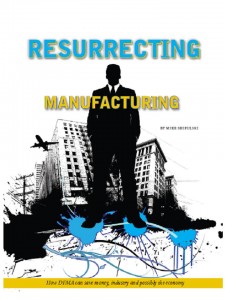Archive for the ‘Robust Economy’ Category
Bring It Back
 Companies (and countries) are slowly learning that moving manufacturing to low cost countries is a big mistake, a mistake of economy-busting proportion. (More costly than any war.) With labor costs at 10% of product cost, saving 20% on labor yields a staggering 2% cost savings. 2%. Say that out loud. 2%. Are you kidding me? 2%? Really? Moving machines all over the planet for 2%? What about cost increases from longer supply chains, poor quality, and loss of control? Move manufacturing to a country with low cost labor? Are you kidding me? Who came up with that idea? Certainly not a knowledgeable manufacturing person. Don’t chase low cost labor, design it out.
Companies (and countries) are slowly learning that moving manufacturing to low cost countries is a big mistake, a mistake of economy-busting proportion. (More costly than any war.) With labor costs at 10% of product cost, saving 20% on labor yields a staggering 2% cost savings. 2%. Say that out loud. 2%. Are you kidding me? 2%? Really? Moving machines all over the planet for 2%? What about cost increases from longer supply chains, poor quality, and loss of control? Move manufacturing to a country with low cost labor? Are you kidding me? Who came up with that idea? Certainly not a knowledgeable manufacturing person. Don’t chase low cost labor, design it out.
(I feel silly writing this. This is so basic. Blocking-and-tackling. Design 101. But we’ve lost our way, so I will write.)
Use Design for Assembly (DFA) and Design for Manufacturing (DFM) to design out 25-50% of the labor time and make product where you have control. The end. Do it. Do it now. But do it for the right reasons – throughput, and quality. (And there’s that little thing about radical material cost reduction which yield cost savings of 20+%, but that’s for another time).
The real benefit of labor reduction is not dollars, it’s time. Less time, more throughput. Half the labor time, double the throughput. One factory performs like two. Bring it back. Fill your factories. Repeat the mantra and you’ll bring it back:
Half the labor and one factory performs like two.
QC stands for Quality Control. No control, no quality. Ever try to control things from 10 time zones in the past? It does not work. It has not worked. Bring it back. Bring back your manufacturing to improve quality. Your brand will thank you. Put the C back in QC – bring it back.
Forward this to your highest level Design Leaders. Tell them they can turn things around; tell them they’re the only ones who can pull it off; tell them we need; tell them we’re counting on them; tell them we’ll help; tell them to bring it back.
What if manufacturing mattered?
 What if it was cool to make stuff? What if we advertised manufacturing’s coolness like we advertise beer and cigarettes? Who would be the celebrity spokesman?
What if it was cool to make stuff? What if we advertised manufacturing’s coolness like we advertise beer and cigarettes? Who would be the celebrity spokesman?
What if we took as much pride in university manufacturing programs as with their football programs? What if great manufacturing programs were as profitable as great football programs? What if fans jammed college stadiums every Saturday to cheer manufacturing competitions? What if they were televised like football games? Who would host the pre-game show?
What if manufacturing was valued like professional sports? The World Series of Manufacturing, The Super Bowl of Manufacturing, The World Cup of Manufacturing? Who would do color commentary?
What if manufacturing thought leaders were celebrated like sports legends? What would kids want to be when they grew up? Whose face would be on the cereal boxes?
What if government understood the importance of manufacturing? Who would lead the charge?
How to Make an American Job Before It’s Too Late: Andy Grove
 An amazing article by Andy Grove, co-founder of Intel, that puts things in perspective. A country’s economy must be based on manufacturing and the jobs it creates. It’s not about the designing and developing. It’s about the manufacturing (and the jobs). End of story.
An amazing article by Andy Grove, co-founder of Intel, that puts things in perspective. A country’s economy must be based on manufacturing and the jobs it creates. It’s not about the designing and developing. It’s about the manufacturing (and the jobs). End of story.
This one’s worth the read.
Please pass this one around.
Cover Story IE Magazine – Resurrecting Manufacturing
 For too long we have praised financial enterprises for driving economic growth knowing full well that moving and repackaging financial vehicles does not create value and cannot provide sustainable growth. All the while, manufacturing as taken it on the chin with astronomical job losses, the thinnest capital investments and, most troubling, a general denigration of manufacturing as an institution and profession. However, we can get back to basics where sustainable economic growth is founded on the bedrock of value creation through manufacturing.
For too long we have praised financial enterprises for driving economic growth knowing full well that moving and repackaging financial vehicles does not create value and cannot provide sustainable growth. All the while, manufacturing as taken it on the chin with astronomical job losses, the thinnest capital investments and, most troubling, a general denigration of manufacturing as an institution and profession. However, we can get back to basics where sustainable economic growth is founded on the bedrock of value creation through manufacturing.
Continuing with the back-to-basics theme, manufacturing creates value when it combines raw materials and labor with thinking, which we call design, to create a product that sells for more than the cost to make it. The difference between cost (raw materials, labor) and price is profit. The market sets price and volume so manufacturing is left only with materials and labor to influence profit. At the most basic level, manufacturing must reduce materials and labor to increase profit. We can get no more basic than that. How do we use the simple fundamentals of reducing labor and material costs to resurrect U.S. manufacturing? We must change our designs to reduce costs using Design for Manufacturing and Assembly (DFMA).
The program is typically thought of as a well-defined toolbox used to design out product cost. However, this definition is too narrow. More broadly, DFMA is a methodology to change a design to reduce the cost of making parts while retaining product function. Systematic DFMA deployment is even broader; it is a business method that puts the business systems and infrastructures to deploy DFMA methods in place systematically across a company. In that way, it is similar to the better known business methodologies lean, Six Sigma and design for Six Sigma.
Click this link for the full story.
a
Click this link for information on Mike’s upcoming workshop on Systematic DFMA Deployment
If you were a country, what would you do?
 If I was a country I would care about the well-being of my people. I would truly care about the health, education, and happiness of my families. That’s easy to say, but hard to pay for. How would I fund it? I would make stuff, lots of stuff. My rationale – jobs, lots of jobs. I would create a sustainable economy built on the bedrock of manufacturing. I’m not talking about designing things, but actually making them, with real factories, real machines, and real people, because as a country, it’s more important to make things than to design them.
If I was a country I would care about the well-being of my people. I would truly care about the health, education, and happiness of my families. That’s easy to say, but hard to pay for. How would I fund it? I would make stuff, lots of stuff. My rationale – jobs, lots of jobs. I would create a sustainable economy built on the bedrock of manufacturing. I’m not talking about designing things, but actually making them, with real factories, real machines, and real people, because as a country, it’s more important to make things than to design them.
The single most important equation for me as a country is
Price – Cost = Profit.
While companies care most about profit, as a country I care most about cost – manufacturing cost. I want to incur the cost of manufacturing within my borders, and for good reason – that’s where jobs and money are. For a product that sells for $100 with a 20% profit margin, costs ($80) are four times larger than profits ($20). No big deal you say? Pretend you are a country and look at the three components of cost from my perspective – labor, materials, and overhead, and then ask yourself if it’s a big deal.
Labor
My people get paid for their time. (For me, as a country, that’s magic.) They buy food, clothing, and shelter and have a little fun. In turn, they pay me income tax, which I use to educate my children.
Material
My dirt, rocks, and sticks are used in products and my people get paid to dig, move, mix, and cut. (More magic.) And the machines to do it all are made by my people. We then make the same trade as above – they buy food, clothes, shelter, they pay me income taxes, and I use the money to pay for healthcare.
Overhead
My dirt, rocks, and sticks are dug and moved to make electricity. My people get paid, they spend, and I provide services. A good trade for all.
I’m not an economist, and I’m oversimplifying things. And I know there’s more than a hint of nationalism here. But, even still, when I pretend to be a country, all this makes sense to me.
If you were a country, what would you do?
Click this link for information on Mike’s upcoming workshop on Systematic DFMA Deployment
 Mike Shipulski
Mike Shipulski